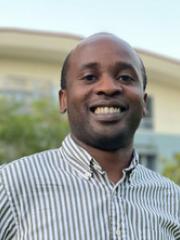Mr Mike Tebyetekerwa

Researcher biography
Mike completed his PhD in Engineering at The Australian National University, Canberra in 2021 with his work focused on developing tools and techniques for advanced characterization of semiconducting materials (2D Materials, Perovskites, and Silicon) and their devices. Mainly for understanding their underlying performance for energy technologies working with Prof Daniel Macdonald, Dr Hieu T. Nguyen, Prof Zongyou Yin, and Prof Yuerui (Larry) Lu. Before that, he obtained his Masters in Materials Processing Engineering (CGPA 91.6/100) from Donghua University, Shanghai-China in 2018 with his thesis focused on fibrous materials for flexible energy storage applications under co-supervision of Prof. Meifang Zhu (Academician Chinese Academy of Science) and Dr Shengyuan Yang. Mike's current research at UQ is inter and multidisciplinary and lies in the integration of high-performance fibrous materials and their performance study with advanced tools, including understanding how these materials can be formed to meet the strict requirements of the circular and green economy in high-performance energy devices. Most current projects are related to energy storage in batteries.
Featured works
- 2022: His work on 2D materials (https://www.cell.com/cell-reports-physical-science/fulltext/S2666-3864(21)00213-7) was selected in the Cell Reports Physical Science "Influential papers-2021" and "Editor's Choice-2021" collection.
- 2021: His works (https://pubs.rsc.org/en/content/articlehtml/2017/sc/c8ee02607f) and other co-authored works (https://www.science.org/doi/full/10.1126/science.abb8687), ( https://doi.org/10.1016/j.carbon.2017.11.012 ) are listed as "Highly Cited Papers" and "Hot Papers" in Web of Science.
- 2020:His work on nanofibers has continuously been listed as one of the highly cited articles for Advanced Fiber Materials (https://doi.org/10.1007/s42765-020-00049-5), since it was published to date.
- 2019:His work on nanofibers ( https://doi.org/10.1021/acsaem.7b00057 ) was listed as the most-read article for ACS Applied Energy Materials in 2018.
